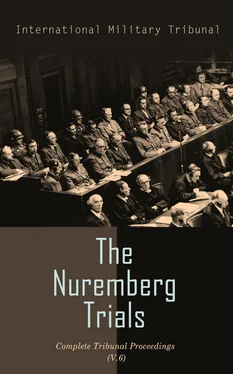I pass to the end of this quotation:
“Whenever, in requisitioning, reference was made to the ordinance of the military commander of 6 August 1942, this was done in order to give the Belgian population the necessary interpretation of the meaning of the principle of the requisition regulations of the Hague Convention.”
Such an interpretation may leave jurists wondering, who have not been trained in the school of National Socialism. It cannot in any case justify the pillage of industry and the subjugation of Belgian production.
These few considerations show how subtle and varied were the methods employed by the Germans to attain their aims in the economic sphere. In the same way as the preceding statements on clearing operations and the utilization of occupation costs, they make it possible to specify the methods employed for exacting heavy levies from the Belgian economy.
Whereas in certain spheres, as in agriculture and transport, it has been possible to assess the extent of economic pillage with a certain exactitude, there are, however, numerous industrial sectors where assessments cannot yet be made. It is true that a considerable part of the industrial losses correspond to the clearing operations, particularly through requisition of stocks. It will therefore be necessary to confine ourselves to the directives of the policy practiced by the Germans.
We may examine briefly the way in which economic spoliation took place in three sectors: industry, agriculture, and transport.
First the industrial sector: The clearing statistics, in the first place, give particulars of the total burdens imposed upon the various industrial branches.
The report of the military administration in Belgium, to which I shall refer constantly, gives the following details, briefly summarized:
From the very beginning of the occupation the Germans demanded an inventory of supplies on which they were to impose considerable levies, notably textiles and non-ferrous metals.
I shall confine myself to some brief remarks on textiles and non-ferrous metals. The example of the textiles industry is particularly revealing: On the eve of the invasion, the Belgian textile industry, with its 165,000 workers, was the second largest industry in Belgium after the metal industry. Under the pretext of avoiding the exhaustion of the very important supplies then still available, an ordinance of 27 July 1940 prohibited the textile industry to work at more than 30 percent of its 1938 capacity. For the period from May to December 1940 alone requisitions were not less than 1,000 million Belgian francs. They particularly affected nearly half of the wool stock available in the country on May 10, 1940, and nearly one-third of the stock of raw cotton.
On the other hand, the forced closing down of factories constituted for the Germans an excellent excuse for taking away, on the pretext of hiring, unused equipment, unless it was requisitioned at a cheap price. The ordinance of 7 September 1942, which is to be found in the document book under Document Number RF-174, laid down the manner in which factories were to be closed in execution of the right accorded to the occupation authorities; and it also gave the right to dissolve certain business and industrial groups and to order their liquidation. Consolidation of enterprises was the pretext given. In the month of January 1944, 65 percent of the textile factories had been stopped.
I shall not go into the details of these operations and I shall pass on to Page 58. The report of the German military administration quoted above gives particularly significant figures as to production. Of a total output of the wool industry of 72,000 tons for the entire period May 1940 to the end of June 1944, representing a value of about 397 million Reichsmark, the distribution of the deliveries between the German and Belgian markets is the following: The German market, 64,700 tons, 314 million Reichsmark; the Belgian market, 7,700 tons, 83 million Reichsmark. The whole spoliation of the textile industry is contained in these figures.
Belgian consumption obviously had to suffer a great deal from the German policy of direction of the textile market. The same report of the military administration furnishes details, stating that in 1938 the needs in textile products amounted in Belgium to a monthly average of twelve kilos. The respective figures for the occupation years are the following: 1940 to 1941—2.1 kilos per head, 1941 to 1942—1.4, 1942 to 1943—1.4, 1943 to 1944—0.7. The diminution of Belgian consumption under the Germans is contained in these two figures; twelve kilos per head in 1938; 0.7 kilo at the end of the occupation.
On the other side, the Belgian Government gives the following details on the pillage of this produce. Compulsory deliveries to Germany during the occupation amounted to:
Cotton yarn, about 40 percent of the production; linen, 75 percent; rayon, 15 percent.
Finally, out of the textile stocks remaining in Belgium a great percentage was still taken away by the Germans through purchases on the Belgian markets, purchases of finished or manufactured products. The equivalent of these forced deliveries can generally be found in the clearing statistics, unless it is placed under misrepresented occupation costs.
I have finished with textiles. As to the non-ferrous metal industry, Belgium was in 1939 the largest producer in Europe of non-ferrous metals, of copper, lead, zinc, and tin. The statistics included in the report of the military command, which are to be found in Exhibit Number RF-173 (Document Number ECH-11), will furnish the evidence for the Tribunal.
On the 18th of February 1941, in connection with the Four Year Plan, the Reich Office for Metals and the Supreme Command of the Army worked out a “metal” plan which provided for Belgian consumption; the carrying out of German orders; exports to the Reich.
These various measures did not satisfy the occupying authorities so they ran a certain number of salvage campaigns which were called “special actions” (Sonderaktionen) in accordance with the method they applied in all the countries of Western Europe. I shall not go into the details of these actions which are described on Page 63 and following of the report; the salvage campaigns for bells, for printing lead, for lead and copper—from information given by the Belgian Government, Document Number RF-146, Page 65 of the report.
In other fields, but without admitting it, the Germans pursued a policy intended to eliminate or to restrict Belgian competition, so that in case of a German victory the economic branches concerned would have had to restrict themselves to the Belgian market, which would then have remained wide open to German business.
These attempts at immediate or future suppression of competition were clearly evident in the case of foundries, glass works, textile industries, construction works, car assembling, construction of material for narrow-gauge railroads, the leather industry, and especially shoe-manufacturing, for which reconstruction of destroyed factories was systematically prohibited.
But in addition, in the textile industry as well as in numerous sectors, especially in the iron-smelting industry, the weakening of the economy cannot be measured only by the scale of the compulsory deliveries but in relation to the policy practiced by the occupying power. Belgian industry, especially coal and iron, suffered considerable losses as a result of directives imposed to finance the war needs at a cheaper rate.
I shall pass over the question of prices of coal. The control of the coal industry was assured by the appointment of a plenipotentiary for coal and by centralization of all sales in the hands of a single organism, the “single seller,” under Belgian direction but with a German commissioner. I am referring to the Belgian coal office, one seller to a single purchaser, “Rheinisch Westfälisches Kohlensyndikat,” which ordered deliveries to be made to the Reich, to Alsace-Lorraine and Luxembourg.
Читать дальше












